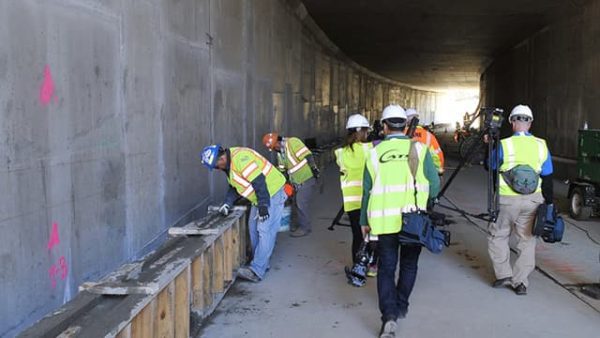Light rail burrows underground, emerges on campus

The LYNX Blue Line Extension project that will bring light rail to the UNC Charlotte campus has reached another milestone. Construction crews have tunneled below North Tryon Street and onto campus, with the path emerging a few hundred feet behind the Bioinformatics Building.
The Charlotte Area Transit System (CATS) organized an event for news media on March 22, allowing reporters – including a crew from the Office of University Communications – to walk through the down-ramp and tunnel.
The Blue Line Extension will expand the rail service from Uptown Charlotte to its terminus on campus. The extension begins at the Seventh Street Station near UNC Charlotte Center City and adds a Ninth Street Station outside the iconic building. There are several other new stations planned for the 9.3-mile alignment along the North Carolina Railroad Corridor and North Tryon Street. Two stations will serve UNC Charlotte directly – one at the intersection of J.W. Clay Boulevard and North Tryon Street, near the Charlotte Engineering Early College building, and the main campus station on Cameron Boulevard, adjacent to Wallis Hall and Parking Lot 25. The light-rail extension is scheduled to be operational by August 2017.
As the alignment travels along the median of North Tryon Street and passes the campus entrance at Institute Circle, the rail line gradually descends under the northbound lanes of North Tryon. The alignment follows an 800-foot ramp downward, in the vicinity of the Bioinformatics Building, flows through a 350-foot tunnel and emerges in an area behind that building. Later, the line bridges Toby Creek and ends at the UNC Charlotte Main Station.
The ramp and tunnel are the only underground portions of the entire LYNX line that extends southward to Pineville near Interstate 485.
David Smith, CATS construction manager, said the ramp and tunnel use the equivalent of 300 dump trucks worth of concrete. The tunnel reaches a depth of 30 feet and follows a construction method known as cut-and-cover, whereby the tunnel is covered and rebuilt with the northbound lanes of North Tryon operating above the top of the tunnel.
Access to the ramp and tunnel is strictly prohibited, and violators may face prosecution, CATS officials said.
“UNC Charlotte has been a great partner on this project,” Smith said.